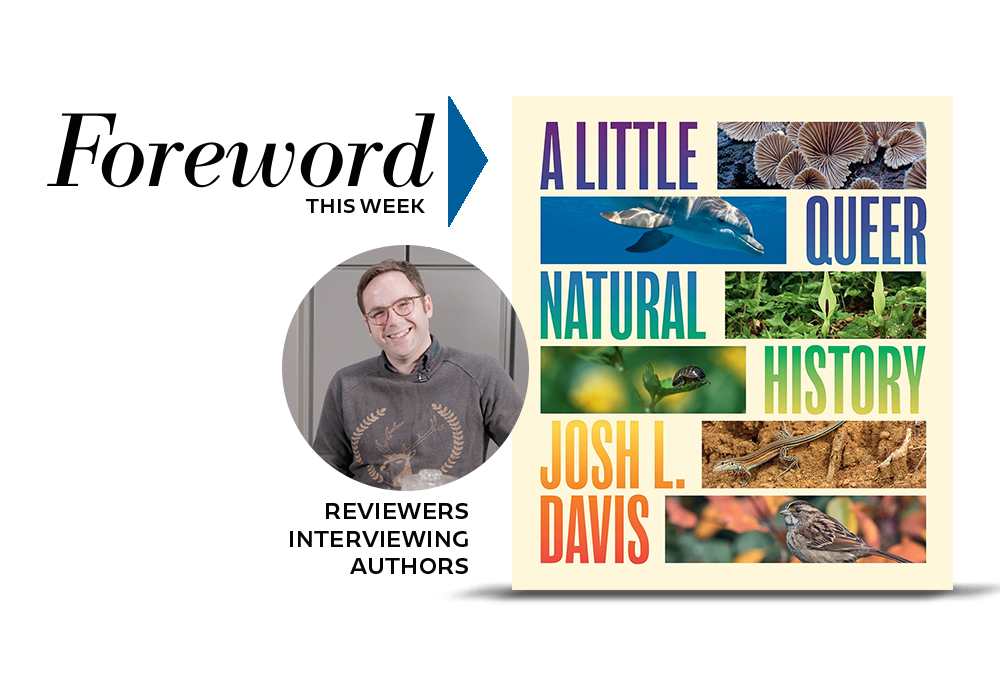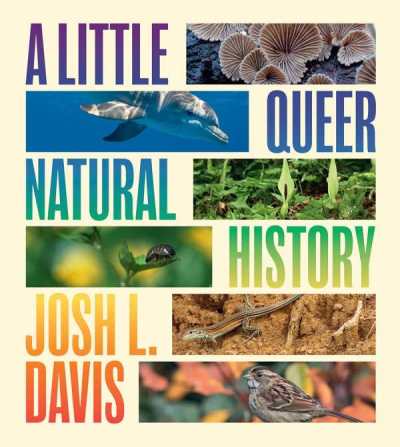Reviewer Kristen Rabe Interviews Josh Davis, Author of A Little Queer Natural History

“Historically, many researchers have assumed that the only purpose of sex is reproduction, and so queer behaviours have been either dismissed or ignored. But we know that this isn’t the case. Sex can have multiple different purposes, such as stress release, conflict resolution, or even just pure pleasure.’’ —Josh Davis
That we are a nation divided is no breaking news, but to look closely at the actual issues that cause our polarization can be a disheartening affair. Take “take America back,” which is just a catchy little political slogan for Trump-supporting Republicans, but if you’re someone who identifies somewhere along the LGBTQ+ spectrum, TAB definitely makes you feel an outsider, a target, fearful in your own country. And that is the purpose.
Can we explain this intolerance for diversity? Yes we can, in a word: religion. Evangelical Christians, especially, cite passages in the Bible to press the case that God disapproves of homosexuality. Another favorite slander from those bullies using Christianity to condemn same-sex love is “God made Adam and Eve, not Adam and Steve”—as if anything other than male-female relationships is an aberration on God’s green Earth.

Josh Davis is here to tell us that science is now making a mockery of that notion. The author of A Little Queer Natural History, Josh notes that homosexual behavior has been officially confirmed in as many as 1500 species, and “it is clear these behaviours are common and prevalent across the entire natural world. … The most obvious assumption then is that most species probably exhibit some form of homosexual behaviour, and being a purely heterosexual species is the exception. While queer behaviours have frequently been presented as something ‘other’ or ‘unnatural,’ it is really doing a disservice to an aspect of nature that is likely exceedingly common and ancient in origin.”
Whoa! Confronting those facts should shock more than a few take-America-back backers—and that’s a good thing. We must never forget that positive change is often a gradual process over generations. If libraries and K–12 science classes start placing Josh’s book and others like it showing how fluid and diverse our world really is, kids today will grow up with much greater levels of tolerance and empathy.
Check out Kristen Rabe’s superb review of A Little Queer Natural History, as well as Chloe Clark’s review of Into the Great Wide Ocean: Life in the Least Known Habitat on Earth, another science project we loved in Foreword‘s September / October issue. If you haven’t yet grabbed your free digital subscription to Foreword Reviews, do it here.
A Little Queer Natural History describes the sexual and reproductive behaviors of twenty-nine plants and animals in detail, and it touches on many others. How did you choose the species highlighted in this book?
The idea of the book was to showcase the sheer range and diversity of non-heteronormative behaviours and biologies. Most people have heard of animals engaging in gay behaviours, but maybe fewer people know that there are all-female species of fish and reptiles.
There was no way this book could be a comprehensive list of all species which show queer behaviours, so the species were selected to reveal the greatest variety, providing a single example from which to hang these fascinating aspects of nature.
I also wanted to highlight the sheer taxonomic range in which these behaviours have been described. When talking about the sexual diversity of nature, for example, people tend to ignore plants. But this does a huge disservice to plants, which include some of the most incredible examples of bending our expectations and challenging our preconceptions about the nature of sex and what it means to life.
Finally, a key aim was to show that queer natural history is all around us. This meant species were picked from every part of the world, with a particular focus on common animals and plants that hopefully many people will already be familiar with.
The book’s title gives the impression that the tone might be cheeky or playful. In fact, the content is rigorous and scientific, though there are certainly lighter moments. What did you set out to accomplish with this book?
What stuck me the most when I started writing and researching this topic was the sheer diversity within these queer behaviours. While we might immediately think about gay animals, queer natural history also includes other fascinating biology such as parthenogenesis, gynandromorphs, and sex-determination.
I wanted to bring these all together to provide a more holistic overview, but I also wanted to provide easy to understand explanations for how these things work. These behaviours are often treated as edge cases or the punchline to jokes—with a refrain that implies this is “not science.” I wanted to show that these behaviours are well-established and have deep scientific grounding. The study of these sexual behaviours is as legitimate as any other research, despite getting much less attention.
These chapters describe such a wide array of sexual and reproductive behaviors in nature that it seems “traditional” heterosexual patterns must be the exception. Can you put these diverse behaviors in a broader context?
Historically, many researchers have assumed that the only purpose of sex is reproduction, and so queer behaviours have been either dismissed or ignored. But we know that this isn’t the case. Sex can have multiple different purposes, such as stress release, conflict resolution, or even just pure pleasure.
Homosexual behaviours have only been officially observed in around 1,500 species; however, as scientists have recorded it and mapped these animals onto the evolutionary tree, it is clear these behaviours are common and prevalent across the entire natural world. It is highly unlikely it is limited to just this handful of species out of the 2.13 million described to date. The most obvious assumption then is that most species probably exhibit some form of homosexual behaviour, and being a purely heterosexual species is the exception.
While queer behaviours have frequently been presented as something “other” or “unnatural,” it is really doing a disservice to an aspect of nature that is likely exceedingly common and ancient in origin.
You note that, historically, queer behavior in nature was often explained away or described as abhorrent or immoral. Can you cite a few examples here? Are attitudes changing in the scientific community?
One of my favourite examples of how queer behaviour has been explained away is within dolphins. Both males and females engage in plenty of gay behaviours, including inserting various body parts (fins, flippers, noses, and penises) into the others’ urogenital slit. When some scientists observed these behaviours, rather than accepting that some animals engage in gay sex (and presumably enjoy it), they thought that it showed “proof” that sexual intercourse was divorced from sexual intentions. These scientists claimed, instead, that the animals were greeting each other or engaging in social behaviour.
Biased human perspectives can subtly influence how animal behaviours are reported. But these biases can manifest in more extreme ways when queer behaviours are covered up entirely. For instance, when researchers observed gay sex among Adélie penguins in 1912, the section on these behaviours was excised from the official account of the expedition. It wouldn’t be until a century later that it was discovered how this behaviour had been observed but then actively redacted.
Attitudes have definitely been changing, with more and more reports of these behaviours being published. While homosexual behaviours in animals are still underreported, this may reflect more about the way journals work rather than researchers’ worries about publishing this information.
But there is still often a subtle bias in language when describing non-heteronormative behaviours even today. For example, for fish species in which males may present as either males or females, almost invariably the female-presenting individuals are described as displaying the “alternative” mating strategy and “stealing” fertilisations, even if those individuals make up more of the population. The implication is that the male-presenting males are the “normal” ones who are somehow “owed” the right to mate, even if that is a value judgement we’ve put onto them.
You mention multiple books and movies that get it wrong, such as the beloved movie Finding Nemo, which inaccurately depicts social systems for clownfish. On the other hand, the successful 2005 children’s book And Tango Makes Three portrays the real-life tale of a pair of male chinstrap penguins in a zoo. Are you seeing changing attitudes and awareness among the creators of popular culture?
It definitely feels as if there has been a shift in recent years, as queer animal couples in zoos get more media coverage, but there is still a massive bias against these behaviours in general.
For example, despite queer behaviours being so common and widespread in nature, they hardly ever feature in nature documentaries. To my understanding, there has only been a single sequence in any of the major David Attenborough documentaries, and even in that case it is excused and explained away.
More recently, the nature documentary Queer Planet was a very welcome addition and a much-needed attempt to redress these imbalances. But in an ideal world these behaviours wouldn’t need their own separate documentary. They would be included within the mainstream ones as interesting enough in their own right.
While books such as And Tango Makes Three are an incredibly notable point in history in which these behaviours were finally talked about more widely (and to a younger audience!), the book also frequently appeared in the lists of banned books in US libraries. Too often, it can feel like a situation in which we take one step forward and two steps back.
Do you believe a more complete, accurate understanding of the array of sexual behaviors in nature will encourage more enlightened assessments of human behaviors?
It is always tricky to draw this parallel between animals and people. The book explicitly states that I’m not setting out to justify these behaviours because these behaviours need no justification.
At the same time, queer behaviours in animals and humans have been entwined from the start. In the 19th century, for example, homosexual behaviour among cockchafer beetles was effectively used as a proxy to talk about the more taboo subject of homosexual behaviour among men. The covering up of observations also likely reinforced the argument that homosexuality in humans was “unnatural” as it was not found in nature.
So, the revelation and open discussion of queer behaviours in animals did disarm that particular argument. We should be talking about all aspects of behaviour in the natural world, as this is the only way we get a full picture of the incredible diversity that exists out there.
Kristen Rabe
